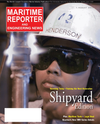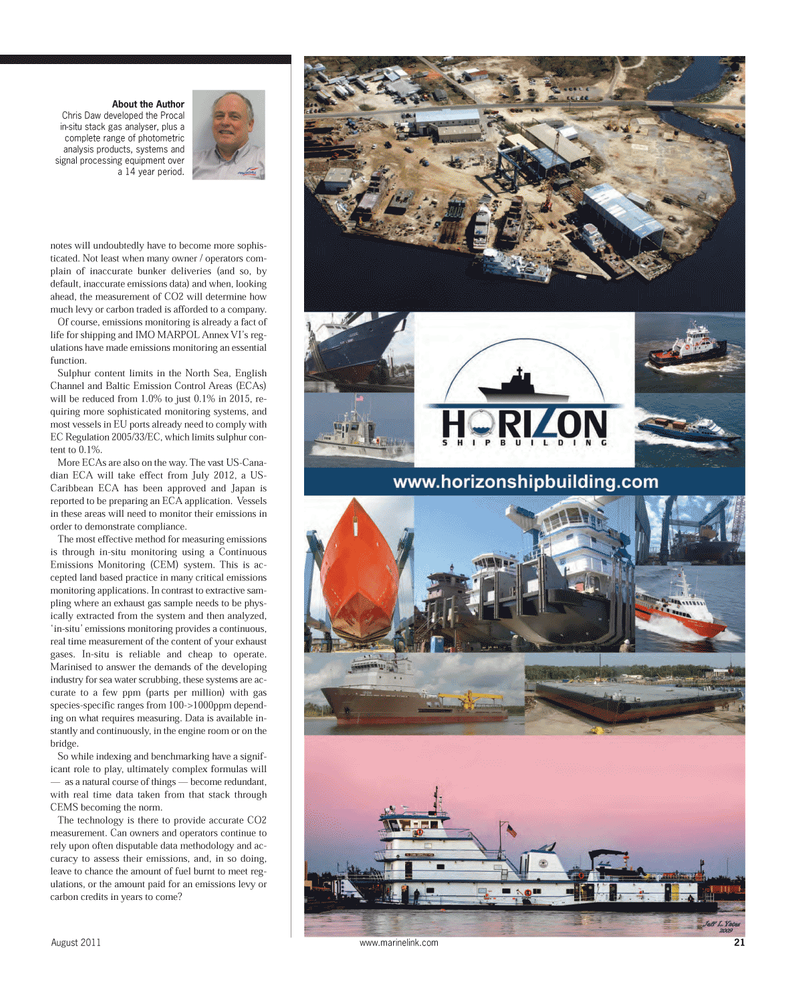
Page 21: of Maritime Reporter Magazine (August 2011)
Top 20 Shipyards of the World
Read this page in Pdf, Flash or Html5 edition of August 2011 Maritime Reporter Magazine
notes will undoubtedly have to become more sophis- ticated. Not least when many owner / operators com- plain of inaccurate bunker deliveries (and so, by default, inaccurate emissions data) and when, looking ahead, the measurement of CO2 will determine how much levy or carbon traded is afforded to a company. Of course, emissions monitoring is already a fact of life for shipping and IMO MARPOL Annex VI?s reg- ulations have made emissions monitoring an essential function. Sulphur content limits in the North Sea, EnglishChannel and Baltic Emission Control Areas (ECAs) will be reduced from 1.0% to just 0.1% in 2015, re-quiring more sophisticated monitoring systems, andmost vessels in EU ports already need to comply with EC Regulation 2005/33/EC, which limits sulphur con- tent to 0.1%.More ECAs are also on the way. The vast US-Cana- dian ECA will take effect from July 2012, a US- Caribbean ECA has been approved and Japan is reported to be preparing an ECA application. Vessels in these areas will need to monitor their emissions inorder to demonstrate compliance. The most effective method for measuring emissions is through in-situ monitoring using a ContinuousEmissions Monitoring (CEM) system. This is ac- cepted land based practice in many critical emissions monitoring applications. In contrast to extractive sam- pling where an exhaust gas sample needs to be phys- ically extracted from the system and then analyzed, ?in-situ? emissions monitoring provides a continuous, real time measurement of the content of your exhaust gases. In-situ is reliable and cheap to operate. Marinised to answer the demands of the developing industry for sea water scrubbing, these systems are ac- curate to a few ppm (parts per million) with gas species-specific ranges from 100->1000ppm depend- ing on what requires measuring. Data is available in- stantly and continuously, in the engine room or on the bridge. So while indexing and benchmarking have a signif- icant role to play, ultimately complex formulas will ? as a natural course of things ? become redundant,with real time data taken from that stack through CEMS becoming the norm. The technology is there to provide accurate CO2 measurement. Can owners and operators continue to rely upon often disputable data methodology and ac-curacy to assess their emissions, and, in so doing, leave to chance the amount of fuel burnt to meet reg- ulations, or the amount paid for an emissions levy or carbon credits in years to come?August 2011www.marinelink.com 21About the AuthorChris Daw developed the Procal in-situ stack gas analyser, plus a complete range of photometricanalysis products, systems and signal processing equipment over a 14 year period.MR Aug. 11 # 3 (18-24):MR Template 8/3/2011 12:06 PM Page 21

 20
20

 22
22
